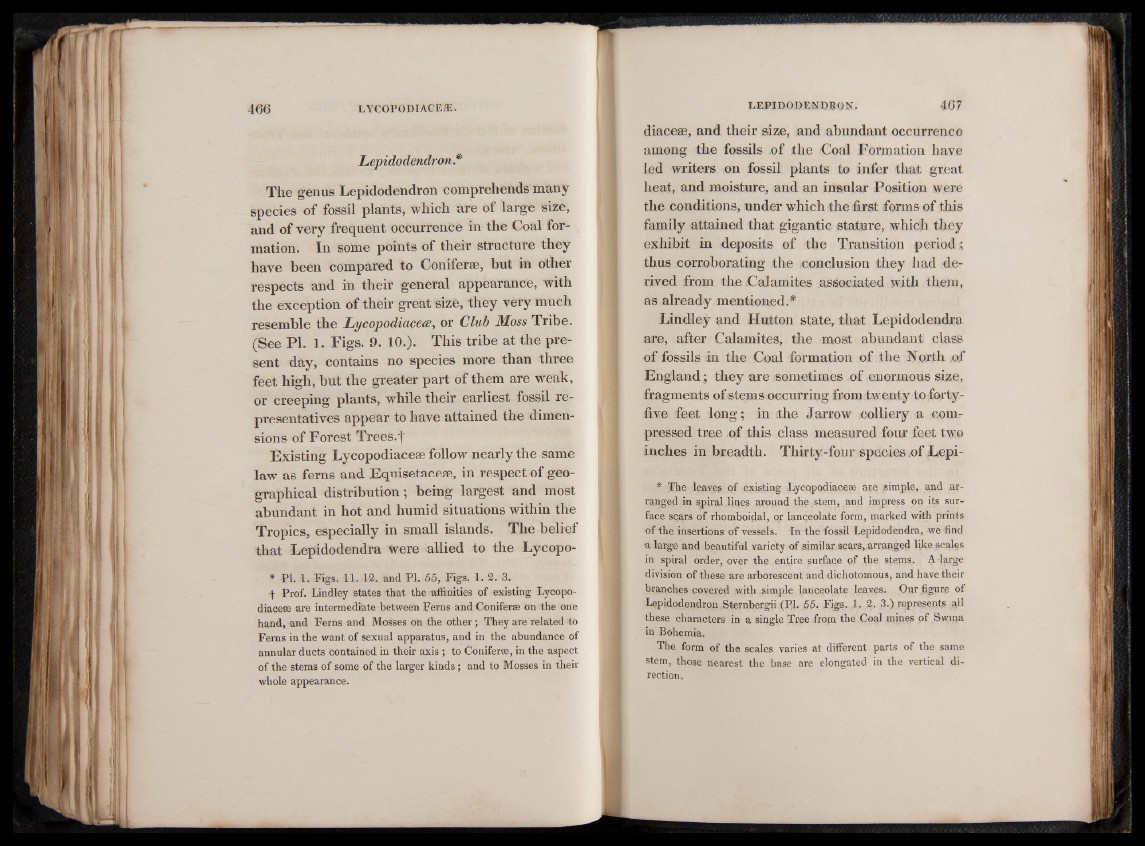
Lepidodendron *
The genus Lepidodendron comprehends many
species o f fossil plants, which are o f large size,
and o f very frequent occurrence in the Coal formation.
In some points o f their structure they
have been compared to Coniferse, but in other
respects and in their general appearance, with
the exception o f their great size, th ey very much
resemble the Lycopodiaceee, or Club Moss Tribe.
(S e e PI. 1. Figs. 9. 10.). This tribe at the present
day, contains no species more than three
feet high, but the greater part o f them are weak,
or creeping plants, while their earliest fossil representatives
appear to have attained the dimensions
o f Forest T r e e s.f
Ex isting Lycopodiaceee follow nearly the same
law as ferns and Equisetacese, in respect o f geographical
distribution; being largest and most
abundant in hot and humid situations within the
Tropics, especially in small islands. The b e lie f
that Lepidodendra Were allied to the Lycopo-
* PI. 1. Figs. 11. 12. and PI. 55, Figs. 1 .2 . 3.
f Prof. Lindley states that the affinities of existing Lycopodiaceee
are intermediate between Ferns and Coniferee on the one
hand, and Ferns and Mosses on the other; They are related to
Ferns in the want of sexual apparatus, and in the abundance of
annular ducts contained in their axis ; to Coniferee, in the aspect
of the stems of some of the larger kinds; and to Mosses in their
whole appearance.
diaceae, and their size, and abundant occurrence
among th e fossils o f th e Coal Formation have
led writers on fossil plants to infer that great
heat, and moisture, and an insular Position were
the conditions, under which the first forms o f this
family attained that gigantic stature, which they
exhibit in deposits o f the Transition period ;
thus corroborating th e conclusion they had derived
from the Calamities associated with them,
as already mentioned.*
Lindley and Hutton state, that Lepidodendra
are, after Calamites, the most abundant class
o f fossils in the Coal formation o f the North o f
E n g la n d ; they are sometimes o f enormous size,
fragments o f stems occurring from twenty to forty-
five feet lo n g ; in the Jarrow colliery a compressed
tree o f this class measured four feet two
inche s in breadth. Thirty-four species ,of Lepi-
* The leaver of existing Lycqpodiacese ace simple, and arranged
in spiral lines around the .stem, and impress on its surface
scars of rhomboidal, or lanceolate form, marked with prints
of the insertions of vessels. In the fossil Lepidodendra, we find
a large and beautiful variety of similar scars, arranged fike scales
in spiral order, over the entire surface of the stems. A large
division of these are arborescent and dichotomous, and have their
branches covered with simple lanceolate leaves. Our figure of
Lepidodendron Sternbergii (PI. 55. Figs. .1. 2. 3.) represents all
these characters in a single Tree from the Coal mines of Swina
in Bohemia.
The form of the scales varies at different parts of the same
stem, those nearest the base are elongated in the vertical direction
.